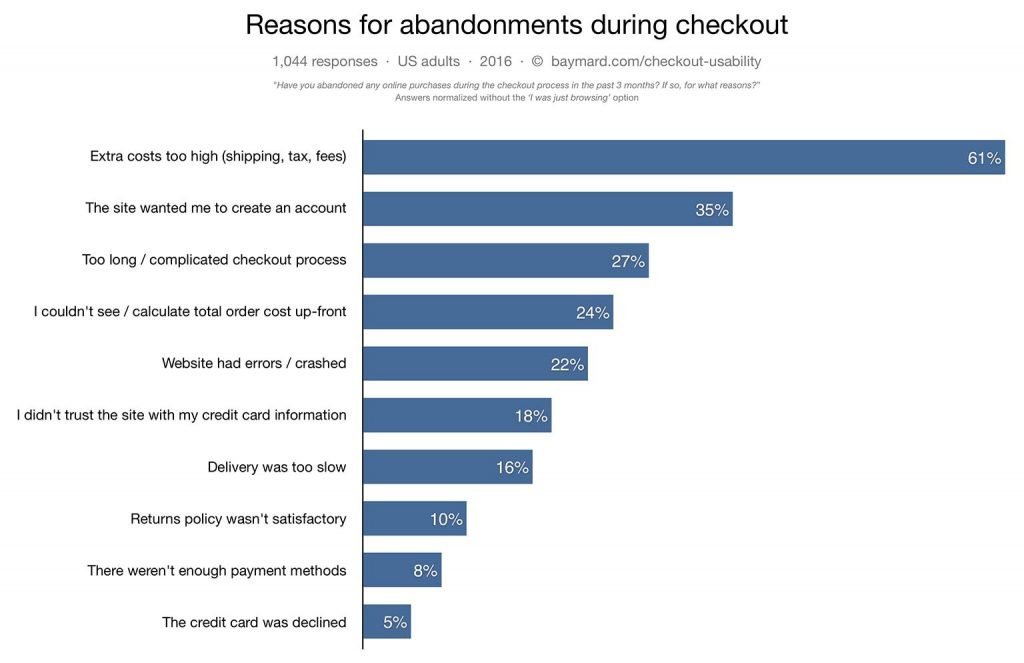Did you know 69{cb377218d5687e54e8ee9149518f87201a393a7c1db5e8076e9d750029ec0dc3} of online shoppers completely abandon their shopping carts before making a purchase?
That’s what the research says according to usability firm Baymard Institute.
Think about it like this:
Say 10 people walk into a grocery store, shop around for things on their list (and maybe a few things that aren’t – the bakery section is always calling!).
When all’s said and done in their shopping experience, 3 of them take their full carts to the checkout, smile as the cashier rings up their items, and pay the bill before heading home.
But for 7 of them, something happens between entering the grocery, starting to fill their carts, and the actual purchase.
Four of them were just taking a look around, they had some time to kill and thought they might like a snack; maybe they grabbed a couple things to think about them a bit, but ultimately they decided they weren’t that hungry and they needed to get a move on.
One of them put one or two items in their cart before checking Facebook, seeing their friends are meeting for drinks nearby right now, and deciding they don’t really need their items now – so they’ll come back later.
Another got all the way to the checkout line, but after waiting for 10 minutes in the crowded store with only 3 items to buy, they decide they’d rather just leave and come back later too.
And the last got all the way to checking out, but because the cashier gave them an unsavory look, they decided they didn’t quite trust handing over their money to them and just walked out.
Top Reasons for Shopping Cart Abandonment
In their study, Baymard makes it clear that 58.6{cb377218d5687e54e8ee9149518f87201a393a7c1db5e8076e9d750029ec0dc3} of US online shoppers abandoned their carts within the last 3 months because they were “just browsing” or “not ready to buy”.
But these aren’t the shoppers you should be worried about – “browsing” is a millennia old part of the process, rooted all the way back in the hunter/gatherer days.
What you really need to know is why people who were ready to buy suddenly changed their minds.
Once you account for the “just browsing” segment, that last 10.4{cb377218d5687e54e8ee9149518f87201a393a7c1db5e8076e9d750029ec0dc3} of abandoned carts is where you can actually make a difference in your sales.
And with research from BI Intelligence revealing approximately $4 trillion worth of merchandise is abandoned on a yearly basis – there’s a huge opportunity, as they also found that smart companies could recover 63{cb377218d5687e54e8ee9149518f87201a393a7c1db5e8076e9d750029ec0dc3} of that lost revenue by streamlining their checkout process.
Based on testing of checkout processes from leading e-commerce sites – such as Walmart, Amazon, and Wayfair – Baymard found that 35{cb377218d5687e54e8ee9149518f87201a393a7c1db5e8076e9d750029ec0dc3} of site owners can fight shopping cart abandonment by simply redesigning their checkout page.
Though you might not realize it, there are certain things you’re doing that might be scaring off potential buyers, and certain things you’re NOT doing that are psychologically proven to make buyers feel more comfortable with and confident about their purchases.
So, if you want to make more sales and keep more customers, then read on to discover our top 5 ways to reduce shopping cart abandonment in order of least to most effective!
5. Include Images of Products Throughout Checkout Process
This is a powerful way to keep the value of your products front and center in your customer’s mind (so powerful we added it to our list even though it wasn’t covered in Baymard’s research – free bonus!).
Think about the process of buying physical goods from a bricks and mortar store.
Throughout the entire shopping process, you’re subconsciously reassuring yourself every item in your physical shopping cart is a worthwhile by literally looking at it throughout your entire shopping journey.
Even if you don’t do it consciously (or that juicy pack of steaks is buried under all the other stuff you’re going to buy), you’re carrying each and every item with you the entire time, a subtle reminder that you’ve already committed to buying it.
And when you finally get to the checkout counter, you have to physically take all of your items out of your cart and watch them get scanned.
So how do you apply the psychology of these subtle commitments and reminders online?
The moment a customer clicks “add to cart,” you should reassure them it was successfully added in one of a few ways:
- By displaying a number of total items in their cart (+ however many they just added)
- By taking them to a “successfully added” page (like Amazon).
- Or maybe even a small popup that confirms their item has been added and what else is already in their cart (like Amazon would do if changing its website didn’t cost billions of dollars).
Then, once they get to the checkout page, you should display a thumbnail version of the product picture.
Even if you have multiple checkout pages, keep the thumbnails of all their in-cart items listed on one side of the screen to act as a visual reminder of what they’ll get when they complete their purchase – so they’ll be less likely to allow a distraction keep them from getting the products they want from you!
4. Use Trust Badges on Your Checkout Page
18{cb377218d5687e54e8ee9149518f87201a393a7c1db5e8076e9d750029ec0dc3} of shopping cart abandonment occurs because users don’t trust the website their shopping on with their credit card information.
Baymard found that many people believed certain pages were more or less secure than other pages; even if this isn’t technically true – for example, if your entire site is secured with HTTPS – most people don’t have the technical insight to understand exactly how your website security works.
So especially when it comes time to enter their credit card info, people will look for any signs that your checkout page is tightly secured with a recognizable trust badge.
As we just mentioned, a common way to signal a secure checkout is with HTTPs, an SSL certificate, and some sort of badge that signals your website is secured this way.
But while it’s most common, HTTPS/SSL isn’t the only way to tell your visitors you care about their security and privacy.
You can also install other security software such as Symantec, Comodo, or TRUSTe.
These go a long way in protecting your customer’s data and making your business look (and actually become) more legitimate.
While security should be a top concern for ecommerce companies, there are other forms of trust badge.
Visual Website Optimizer ran a test for one of their clients and found that by adding a simple trust badge that read “100{cb377218d5687e54e8ee9149518f87201a393a7c1db5e8076e9d750029ec0dc3} money back guarantee” they increased their conversion by 32.57{cb377218d5687e54e8ee9149518f87201a393a7c1db5e8076e9d750029ec0dc3}.
While not website security related, money back guarantees still offer the peace of mind that comes with knowing if for any reason they don’t like the products they’ve bought, they can return them at little to no cost.
Ultimately buyers need their fears dispelled in order to feel comfortable enough to make buying decisions. So help them realize they’re making a good choice by using trust badges on your checkout page!
3. Reduce Checkout Form Elements
Baymard also found that 27{cb377218d5687e54e8ee9149518f87201a393a7c1db5e8076e9d750029ec0dc3} of shopping cart abandonment occurs for a relatively simple reason:
The Checkout process is “too long/complicated.”
Their usability tests showed that the ideal checkout flow should be restricted to 12-14 form elements, yet the average amount of form elements used by US ecommerce sites was 23.
That means that by cutting their form elements in half, most site owners can see significant reductions shopping cart abandonment.
And, if you can, stop using multi-page checkouts; just like too many form elements can be overwhelming, so too is trudging through page after page just to get to the “order now” button.
Instead, try to condense your entire checkout process to just one or two pages, and if you must have multiple pages for checkout, use a progress bar that displays how far along your shopper is in their checkout journey.
Recent research from Statistic Brain suggests that humans now have lower attention spans than a goldfish – so each and every task you ask someone to complete is another second they’re losing interest and becoming more distracted.
Fewer fields to complete and “you’re almost there” progress bars can help keep them engaged while gently guiding them closer to the sale. And remember: by making your checkout process shorter, you’re making 27{cb377218d5687e54e8ee9149518f87201a393a7c1db5e8076e9d750029ec0dc3} of online shoppers more likely to actually buy from you.
2. Ask Users to Register for an Account After the Sale, Not Before
35{cb377218d5687e54e8ee9149518f87201a393a7c1db5e8076e9d750029ec0dc3} of shopping cart abandonment occurs because ecommerce sites make customers create an account in order to make a purchase.
Requiring a customer to create an account on your site before being able to make a purchase is sort of like a tax on their time – you’re making it more difficult for them to make a purchase without really adding value to their order (sure, next time it might be easier to purchase by logging in, but there won’t be a next time if there’s not a this time!).
Why lawmakers raise taxes on tobacco products (besides revenue)? To deter people from buying them.
Do you really want to deter potential customers from buying through from you?
We’d guess not.
So instead, offer a “guest account” option that streamlines the checkout process and makes it easy for the customer to buy first. Then, on the “thank you” screen, offer to create an account for them in order to make checkout even faster next time.
This is a win-win for 2 reasons:
- You’ve made it easy to purchase from you at all.
- You’re offering to make the checkout process even easier to purchase from you next time.
In a time and attention strapped world, easy sells.
And as an added bonus, by creating accounts and capturing emails from actual customers, you’ll be able to build an email list that you can turn into a valuable resource going forward.
1. Reduce Your Shipping Cost (aka Make It Free)
Well, you’ve finally made it to the last thing any business wants to do, even if they know it will increase customer conversion – lower their prices.
It’s a hard fact to swallow, but the biggest reason for cart abandonment is high hidden costs like shipping fees and taxes. 61{cb377218d5687e54e8ee9149518f87201a393a7c1db5e8076e9d750029ec0dc3} of potential buyers will abandon their cart if you try to slyly tack on additional costs at checkout.
But as a smart,web-savvy business, you’re not going to do that (at least, not anymore).
The most important step to take here is to be completely honest about extra costs.
The moment your customer adds something to their cart, you should calculate tax and display it with their total. Being transparent beats being sneaky in the long run because you build trust before the sale – which makes that sale more likely – instead of breaking what trust you’ve built up right before someone is ready to buy, which results in losing both the sale and a customer.
The second step is to try and offer free shipping (even if it costs you).
The big ecommerce retailers have been doing it for so long it’s no wonder most consumers expect everyone, including small businesses, to follow suit; a 2011 Comscore study suggested that 61{cb377218d5687e54e8ee9149518f87201a393a7c1db5e8076e9d750029ec0dc3} of consumers are likely to cancel their entire purchase if free shipping is not offered.
If you absolutely can’t afford free shipping for each and every one of your items, then create different bundles of products or have “free shipping on orders over $x” to make enough money to cover shipping on all products while still making a profit.
At the very least, offer free shipping for special holidays.
Either a 1-day or 1-week free shipping offer can easily spike sales during peak buying months.
Now as an added bonus, we have 1 more step you can take to reduce shopping cart abandonment:
Always have enough stock to meet customer demand.
Make Sure Shoppers can Fill Their Carts… Even if They’re Going to Abandon Them
One of the quickest ways to damage your reputation and bottom line is greeting would-be customers with the dreaded “out of stock” sign.
Are you able to easily and automatically track your products from raw good to sale in order to always have just the right amount of stock?
If not, you need a better way to manage your inventory: one that offers better metrics on your customer’s buying decisions while helping you keep a close eye on your inventory levels across your warehouses and sales channels.
Automate tracking, integrate product info with major ecommerce platforms, and keep track of your sales throughout the year with cloud-based inventory management software.
Ready To Take Back Control of Your Inventory?
Experience the automation and real-time reporting benefits modern cloud-based inventory management software offers by starting your free 14-day trial of DEAR Inventory today!
No Credit Card Required


